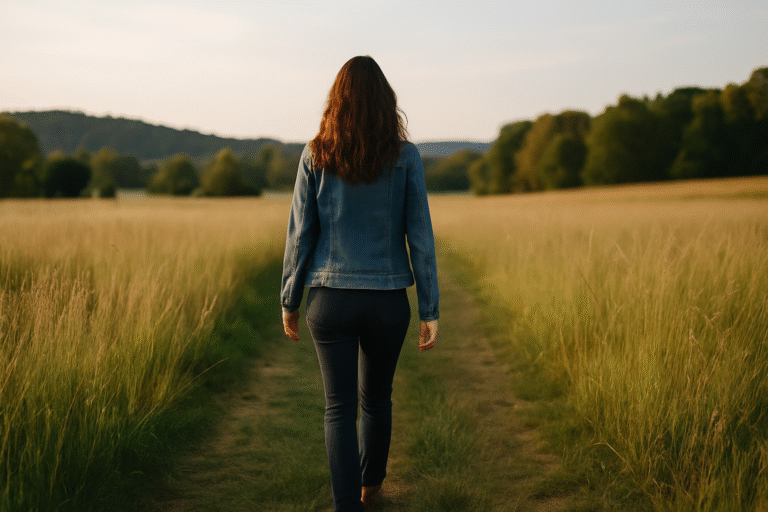September brings renewal, the crisp promise of fresh starts, new rhythms, and a gentle turning inward. As summer’s expansive days give way to more structured routines, many of us feel both the excitement of new possibilities and the intensity of fuller schedules. This season offers something beautiful: the chance to discover calm not as something we need to find time for, but as something that can live within the life we’re already living.
The transition itself holds wisdom. While earlier mornings and busier calendars are real, they also create opportunities to weave small, meaningful practices into our days. Calm doesn’t have to be another item on your list. It can be found in the smallest embodied gestures, moments of movement, sound, or stretch that transform ordinary activities into opportunities for reset and renewal. These practices don’t require extra time; they’re ways of inhabiting the time you already have with greater presence and ease.
Why Your Body Knows What Your Mind Forgets
Our bodies and minds are not separate. How we move, breathe, and carry ourselves shapes how we feel. Even very small practices can shift the nervous system and create a pocket of space.
What’s particularly interesting is that our natural rhythms work against us during this season. We tend to move more in summer and become more sedentary in fall and winter, just as schedules grow busier (Mailey et al., 2021). That means the body naturally slows while the demands of life increase. No wonder so many of us feel tired. The invitation is not to push harder, but to notice where we can bring gentle movement, rhythm, or sound back into our days.
Movement as Medicine: The Science of Small Practices
Dance Without Performance
Dance does not have to be a performance or a class. It can be a short burst of movement in the living room, swaying to a favorite song while cooking, or stepping side to side at the kitchen counter.
What’s remarkable about even these small movements is how powerfully they can shift our emotional state. Dance and movement practices meaningfully reduce depression and anxiety while improving quality of life (Koch et al., 2019). Even a few minutes can reset the emotional tone. For parents, this might look like a two-minute dance break during homework time or a family “dance party” before bed. These small playful moments help release tension and often create laughter, which is its own form of medicine.
The Healing Power of Voice
The voice is one of the simplest ways to regulate mood. When older adults join choirs, they experience significant reductions in depression and anxiety, even compared to other beneficial activities like health education programs (Ng et al., 2025). But you do not need a formal choir.
Humming in the car, singing while folding laundry, or making up songs with children can bring the same calming effect. The vibration of voice moves through the body, helping regulate breath and creating a sense of connection. Parents often find that bedtime songs soothe not only children but themselves.
Music as Emotional Companion
Music shifts how we feel effort and how we experience stress. Across dozens of studies, researchers have found that music improves mood and reduces the sense of strain during physical activity (Terry et al., 2020). In psychedelic therapy, patients describe music as a partner in the healing process, guiding emotions during sessions and helping them integrate insights afterward (Dwyer et al., 2025).
In daily life, this can be as simple as a playlist for morning routines, a calming set of songs before sleep, or a playful soundtrack for chores. Music can carry us gently from one part of the day to the next.
The Wisdom of Simple Movement
Walking as Reset
Walking remains one of the most reliable ways to shift mood. Even a single session of aerobic exercise helps people recover from stress more effectively (Bernstein & McNally, 2017). A ten-minute walk after dinner, or even a stroll to the mailbox, can reset both body and mind. For parents, inviting children on a short walk after school creates connection while easing the physical tightness of the day.
Strength in Small Doses
Exercise more broadly is linked to mental health benefits. Resistance training reduces depressive symptoms across age groups (Gordon et al., 2018). This does not require a gym or long blocks of time. Bodyweight squats, a few minutes with a resistance band, or stretching while waiting for coffee are enough. These short practices count.
Yoga and the Art of Presence
Yoga brings breath, attention, and movement together in ways that support emotional balance. Multiple studies show significant reductions in depressive symptoms when people engage in yoga practices regularly (Cramer et al., 2018).
Yoga does not have to be a full class. Three slow breaths in a standing pose or a gentle forward bend before bed can be enough. Stretching more generally can also bring relief. Lifting your arms, rolling your shoulders, or leaning into a stretch at the counter provides a small but real sense of ease. These practices can take less than a minute but help restore balance during long days.
Play as Pathway to Connection
For some people, calm arrives through play. Adults who participate in recreational sports report better mental health and higher life satisfaction (Eime et al., 2020). Joining a weekly game, playing tennis, or kicking a soccer ball with children combines movement with connection. These activities are not about performance. They are about belonging, laughter, and remembering that life is more than schedules and tasks.
Beginning Where You Are
If you already feel stretched thin, know that you do not have to do everything. Choose one practice that feels easy and natural. Try it once or twice this week. Let it be light. You might notice that even a single song, a short walk, or a breath with arms overhead can shift your state.
The goal is not perfection. The goal is to let calm be possible in the middle of a busy life. Parents often discover that children benefit as much as they do from these moments. What begins as a small act for yourself often becomes a shared practice for the family.
A Practice, Not a Performance
Seasonal change can bring fatigue and stress. It is normal to feel overwhelmed. You do not need to add one more assignment to your list. Instead, you can claim calm in the body you already inhabit. A stretch, a song, a few steps, or a game of catch are all invitations into balance.
At AK Psychology Group we encourage patients and families to see these practices not as extras but as companions to everyday life. Calm is something we practice, protect, and allow. Even in the busiest season, small embodied acts can carry the ease of summer into the pace of fall.
References
Bernstein, E. E., & McNally, R. J. (2017). Acute aerobic exercise helps overcome emotion regulation deficits. Cognition and Emotion, 31(4), 834–843. https://doi.org/10.1080/02699931.2016.1168284
Cramer, H., Lauche, R., Langhorst, J., & Dobos, G. (2018). Yoga for depression: A systematic review and meta-analysis. Depression and Anxiety, 35(9), 830–843. https://doi.org/10.1002/da.22762
Dwyer, J., Johnston, R. B., O’Callaghan, C., Kallianis, V., & Ross, M. L. (2025). Music as a collaborating actor: New insights into the nature and role of music in psychedelic-assisted psychotherapy. Frontiers in Psychiatry. https://doi.org/10.3389/fpsyt.2025.1541528
Eime, R. M., Young, J. A., Harvey, J. T., Charity, M. J., & Payne, W. R. (2020). A systematic review of the psychological and social benefits of participation in sport for adults. BMC Public Health, 20(1), 1–20. https://doi.org/10.1186/s12889-020-08703-8
Gordon, B. R., McDowell, C. P., Lyons, M., & Herring, M. P. (2018). Resistance exercise training for anxiety and worry symptoms among young adults: A randomized controlled trial. JAMA Psychiatry, 75(6), 566–576. https://doi.org/10.1001/jamapsychiatry.2018.0576
Koch, S. C., Riege, R. F., Tisborn, K., Biondo, J., Martin, L., & Beelmann, A. (2019). Effects of dance movement therapy and dance on health-related psychological outcomes: A meta-analysis update. Frontiers in Psychology, 10, 1806. https://doi.org/10.3389/fpsyg.2019.01806
Mailey, E. L., Rosenkranz, S. K., Casey, K., Jiang, Y., & Rosenkranz, R. R. (2021). Seasonal variation in physical activity, sedentary behavior, and sleep in a large sample of U.S. adults: An analysis of device-based measures. International Journal of Behavioral Nutrition and Physical Activity, 18(1), 122. https://doi.org/10.1186/s12966-021-01091-1
Ng, T. K. S., Chow, I. H. Y., Mak, W. W. S., Lai, F. H. Y., Lam, L. C. W., & Chan, W. C. (2025). Effects of choral singing on depression and anxiety in older adults: A randomized controlled trial. Journal of Psychiatric Research, 174, 33–41. https://doi.org/10.1016/j.jpsychires.2025.05.061
Terry, P. C., Karageorghis, C. I., Curran, M. L., Martin, O. V., & Parsons-Smith, R. L. (2020). Effects of music in exercise and sport: A meta-analytic review. Psychological Bulletin, 146(2), 91–117. https://doi.org/10.1037/bul0000216








